Abstract
In the present study, the authors investigated the mechanism by which Al3+ preincubations inhibited the pathologic calcification of glutaraldehyde-pretreated bovine pericardium (GPBP) implanted subdermally in rats. The concentration dependency of the Al3+ anticalcification effect was compared with that of other trivalent metal ions (Fe3+, Ga3+, La3+) known to interact with calcium phosphates. In vitro incubations of GPBP were carried out in AlCl3 (10(-3) mol/l [molar] to 10(-1) mol/l) to ascertain both the optimal conditions for uptake of Al3+ and the time course of Al3+ dissociation. Al3+ uptake by GPBP was concentration dependent and occurred rapidly, with tissue levels after 1 hour not differing significantly from those after 72 hours of incubation. Analyses of GPBP samples preincubated in AlCl3 (0.1 mol/l, 24 hours) showed that more than 75% of the Al3+ remained tightly bound after 60 days' in vitro release at 37 degrees C, pH 7.4. Preincubations of GPBP in AlCl3 significantly inhibited calcification after subdermal implantation in rats for 60 days (Ca++ = 5.1 +/- 0.9 microgram/mg, 11.5 +/- 4.6 micrograms/mg, 70.3 +/- 23.0 micrograms/mg, mean +/- standard error [SE], for 10(-1) mol/l, 10(-2) mol/l, 10(-3) mol/l AlCl3, respectively), compared with controls (Ca++ = 110.0 +/- 9.3 micrograms/mg). All animals were free of Al3(+)-mediated adverse effects on bone, as determined by light microscopic evaluation of femoral epiphyseal growth plates. Transmission electron microscopy coupled with electron energy loss spectroscopy (EELS) of GPBP incubated in 10(-1) mol l AlCl3 for 24 hours demonstrated discrete Al3+ localization in the sarcolemma and cytoplasmic and nuclear membranes of devitalized pericardial connective tissue cells at intracellular sites coincident with phosphorus loci. Similar intracellular localization remained prominent in explants removed after 60 days; no calcific deposits were noted in these specimens. Preincubations in Fe3+ but not Ga3+ and La3+ solutions yielded significant inhibition of GPBP calcification, which did not differ significantly from that provided by Al3- and had a comparable concentration dependency. Light microscopic examination (Prussian blue staining) and EELS of FeCl3-preincubated explants demonstrated Fe3+ localization within devitalized GPBP connective tissue cells. The authors conclude that Al3+ and Fe3+ significantly inhibit the pathologic mineralization of glutaraldehyde-pretreated bovine pericardium by mechanisms that are likely related to the high affinity of these cations for membrane associated and other intracellular phosphorus loci.
Full text
PDF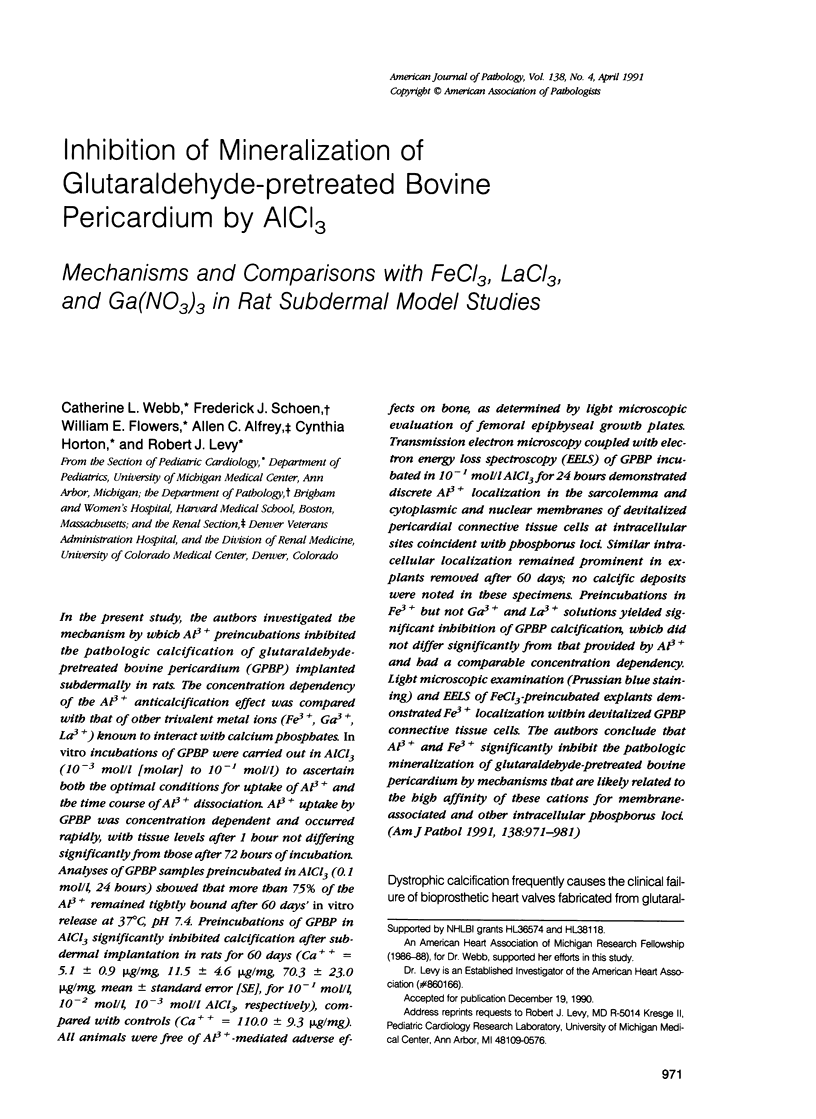
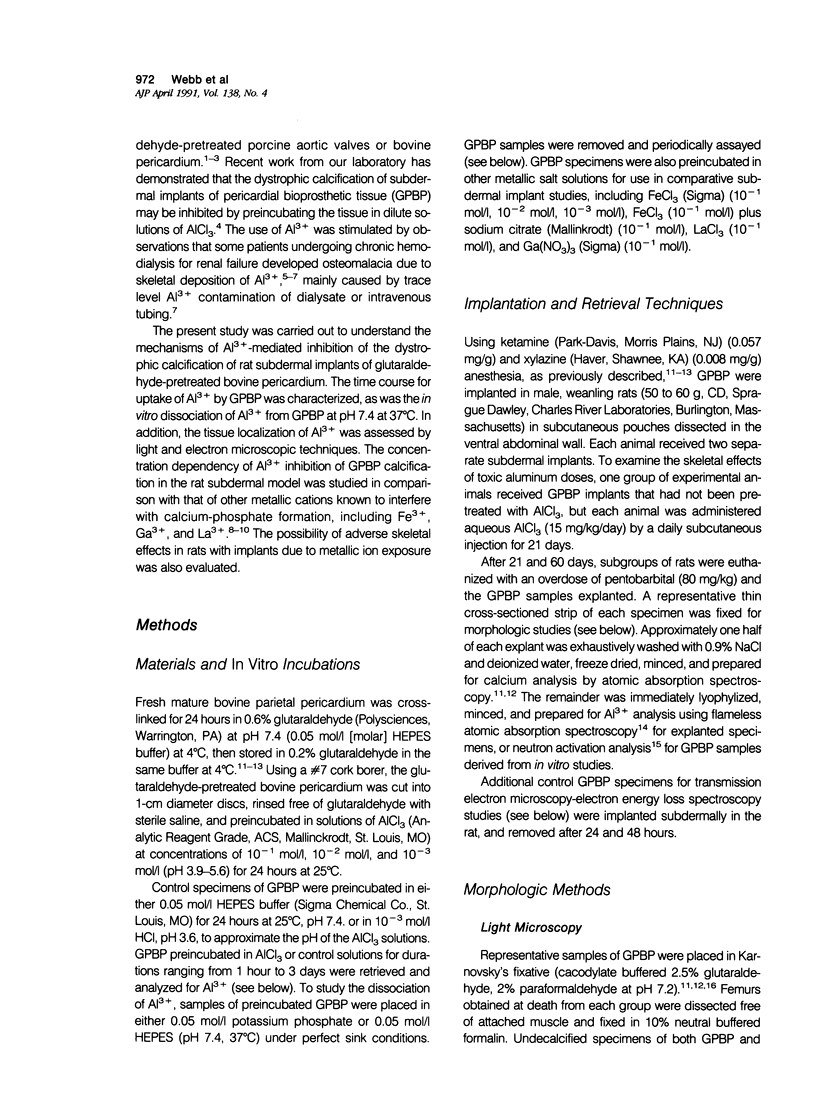
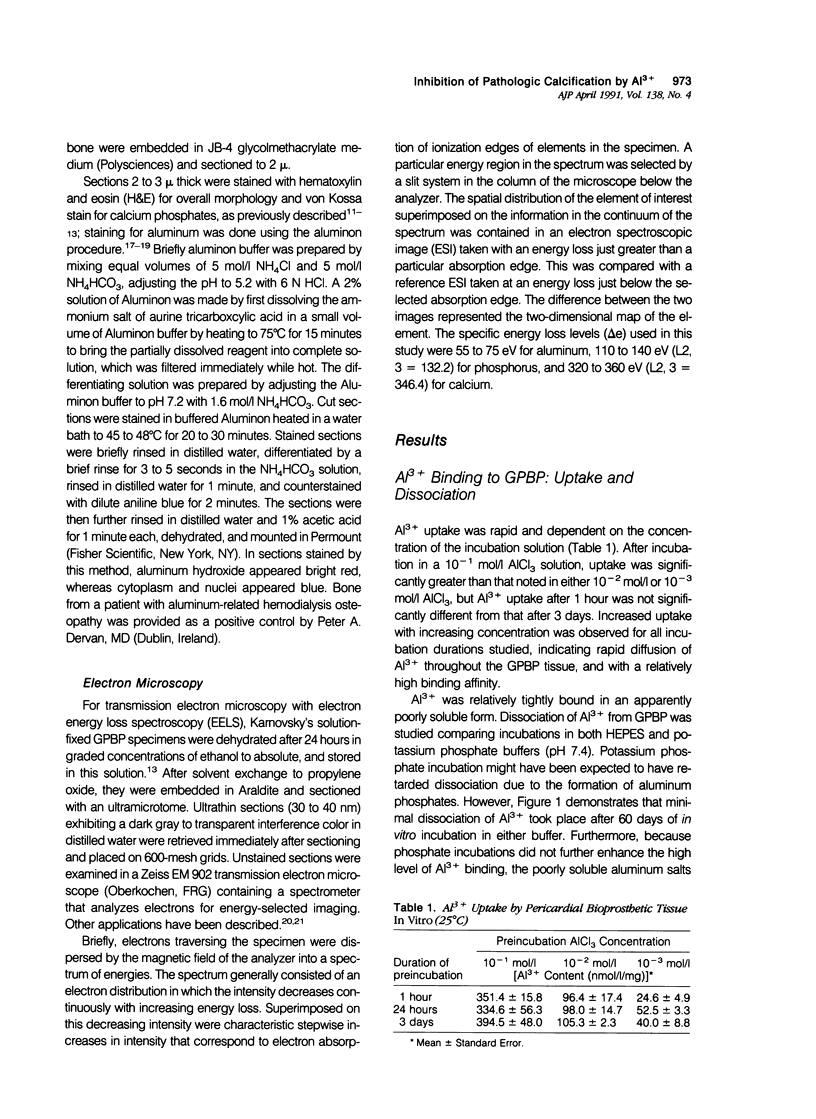
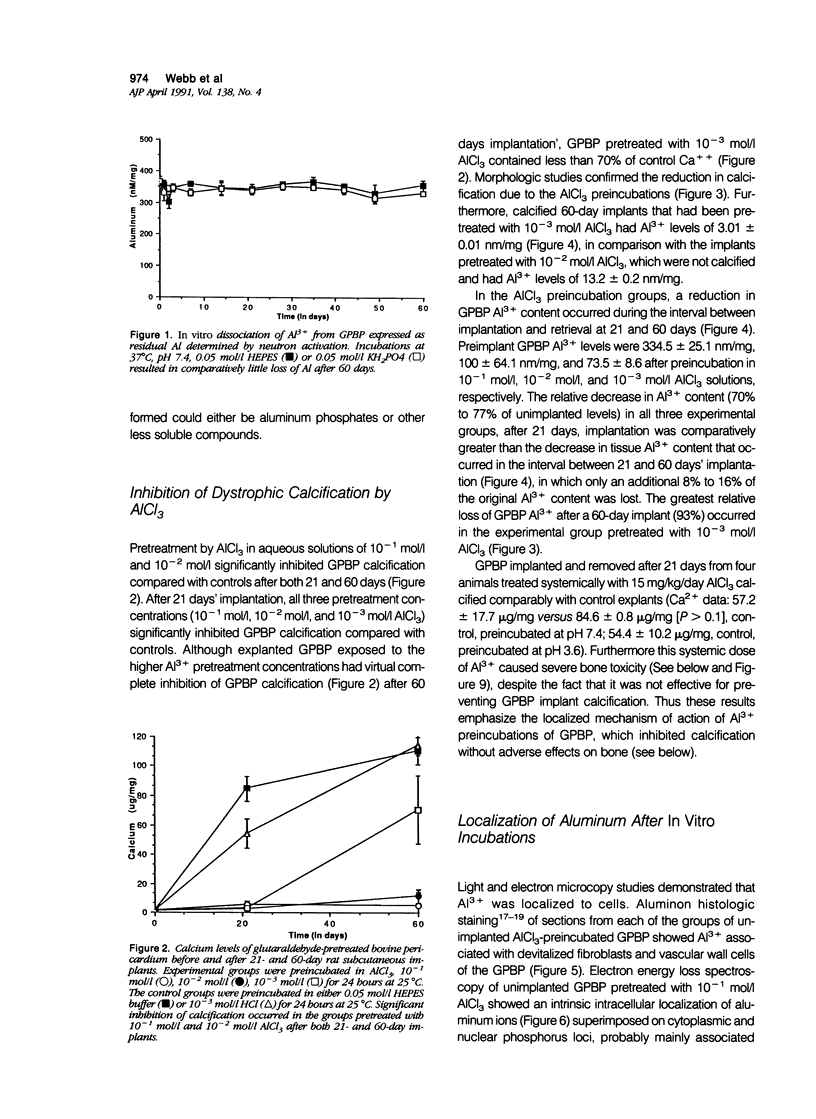
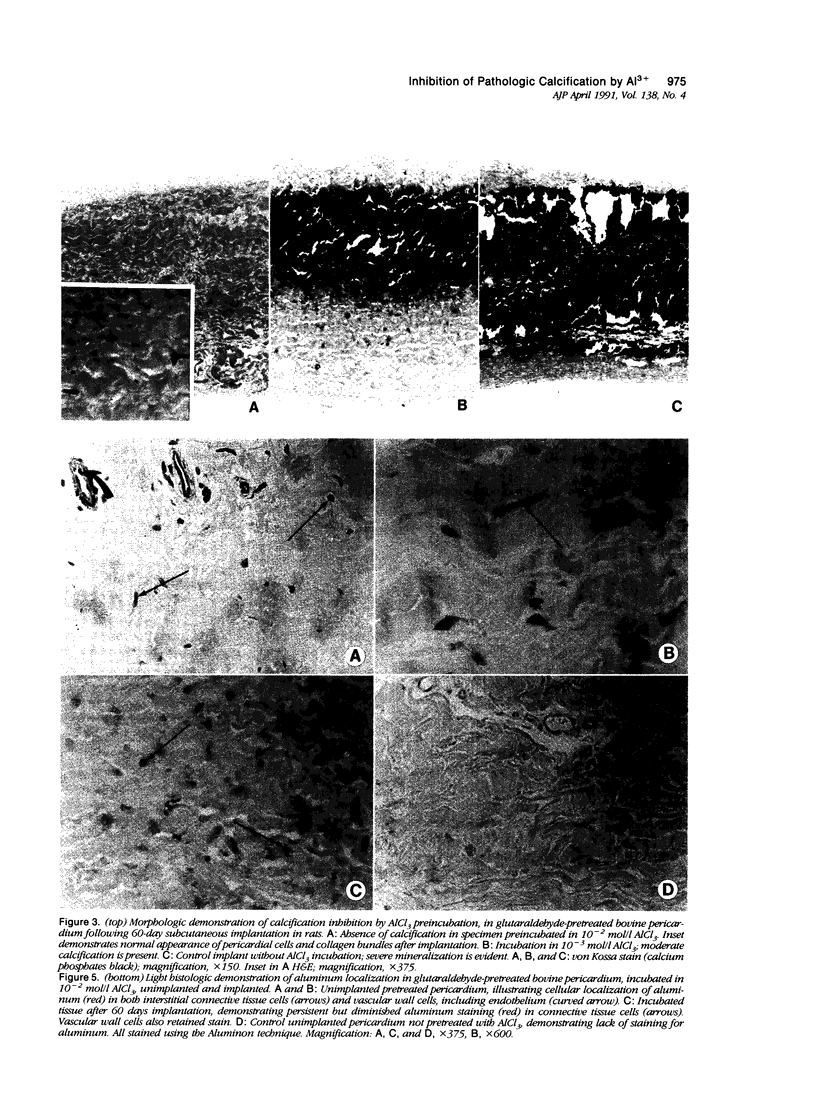
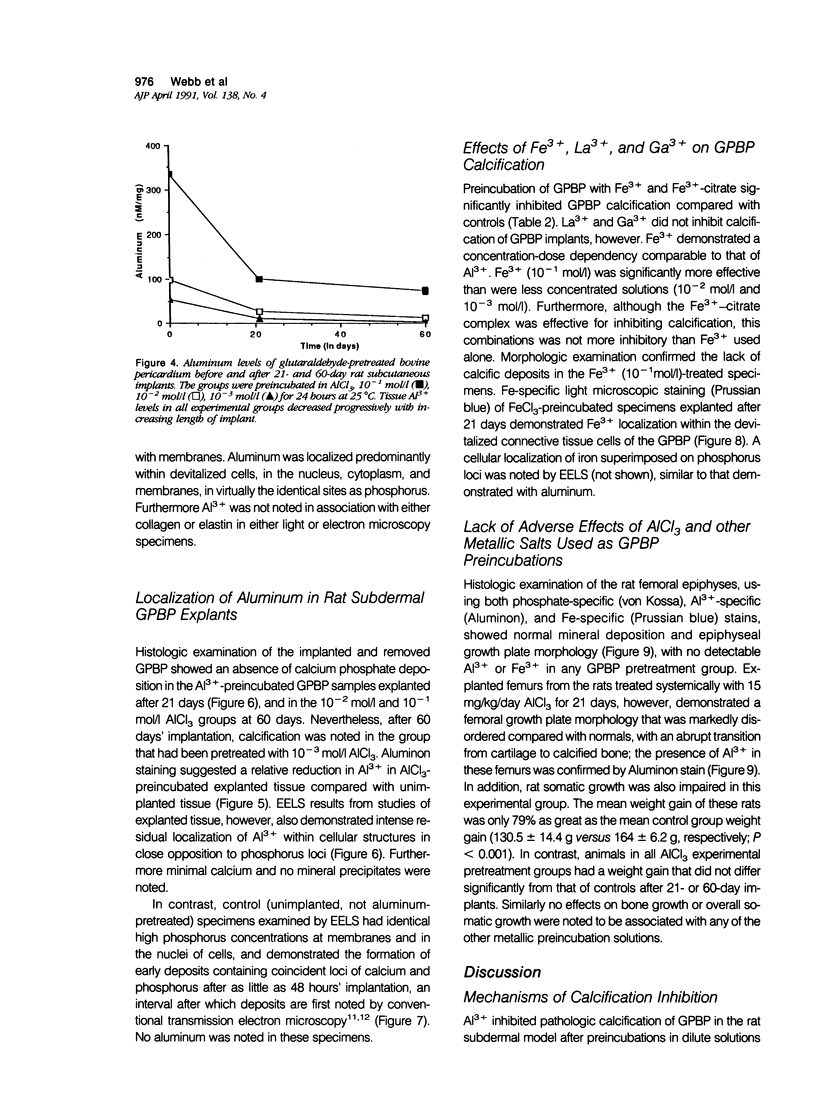
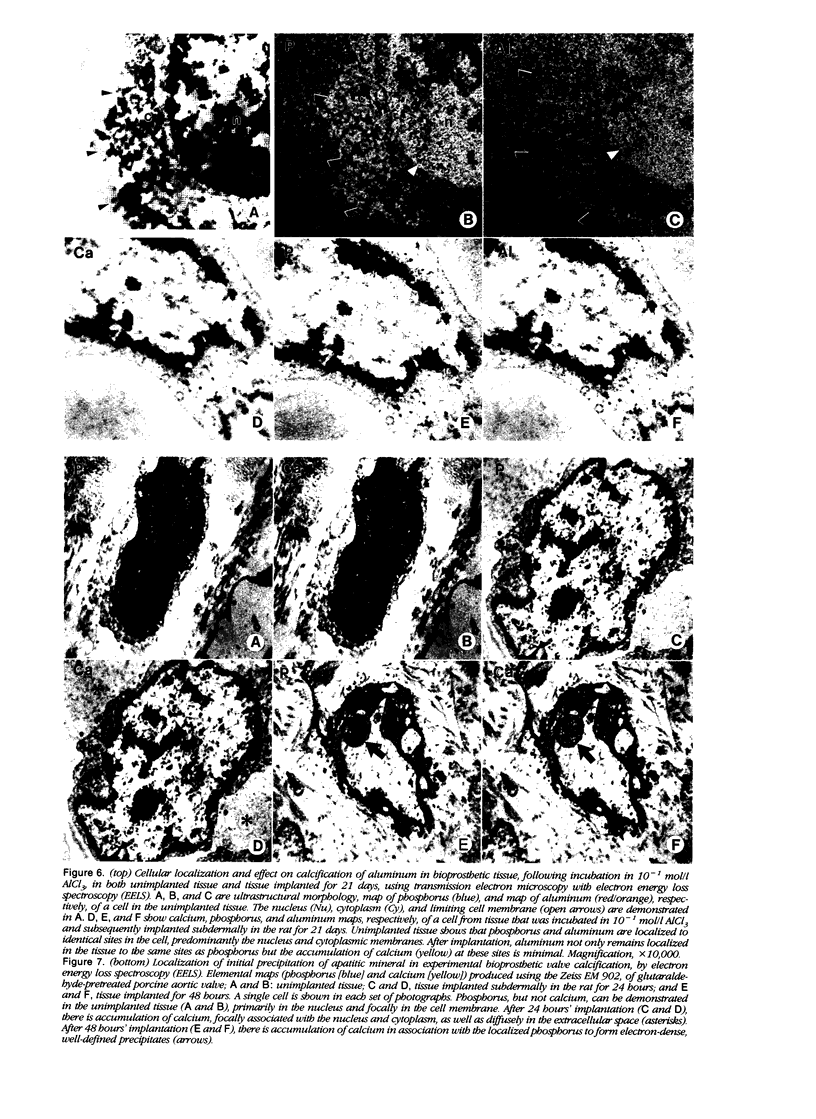
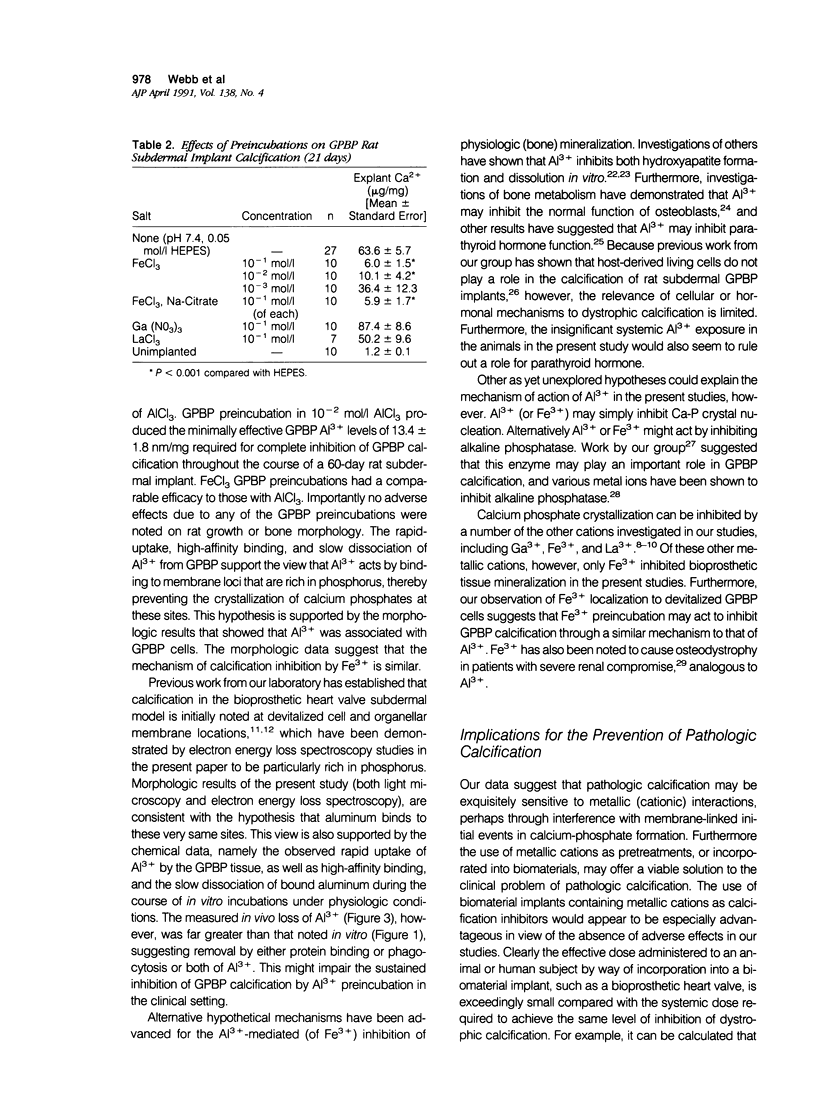
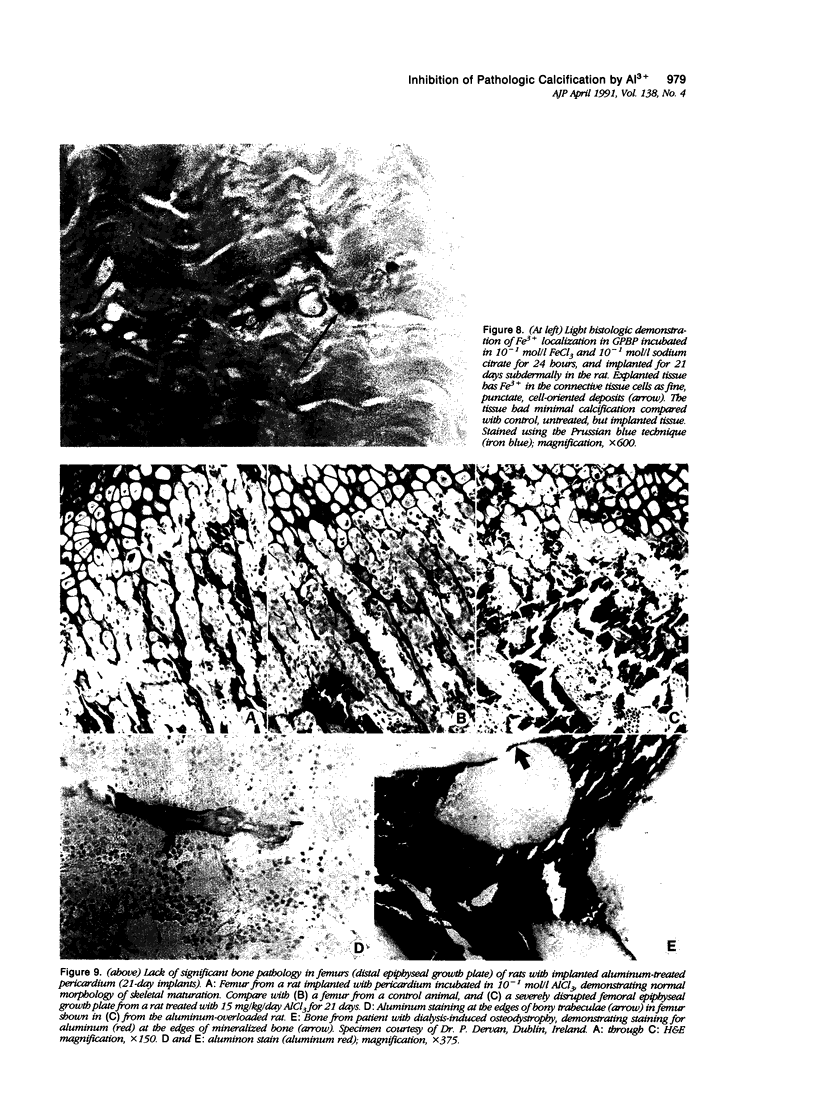
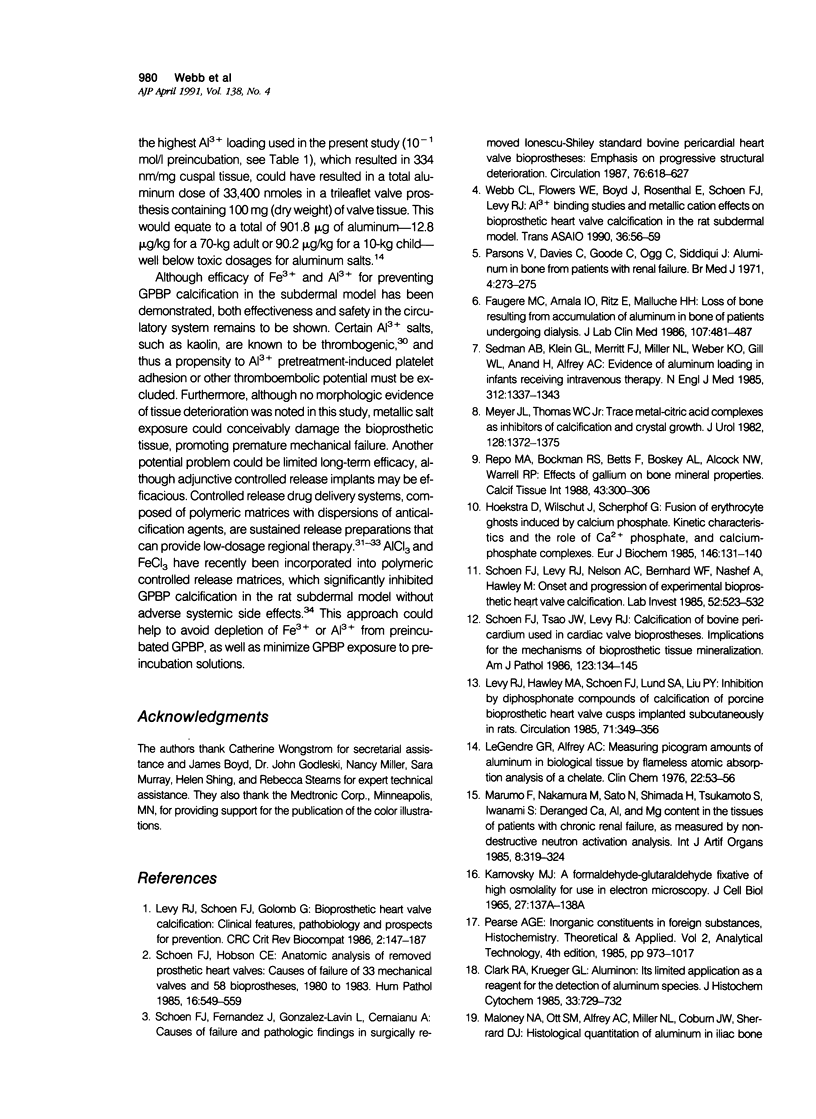
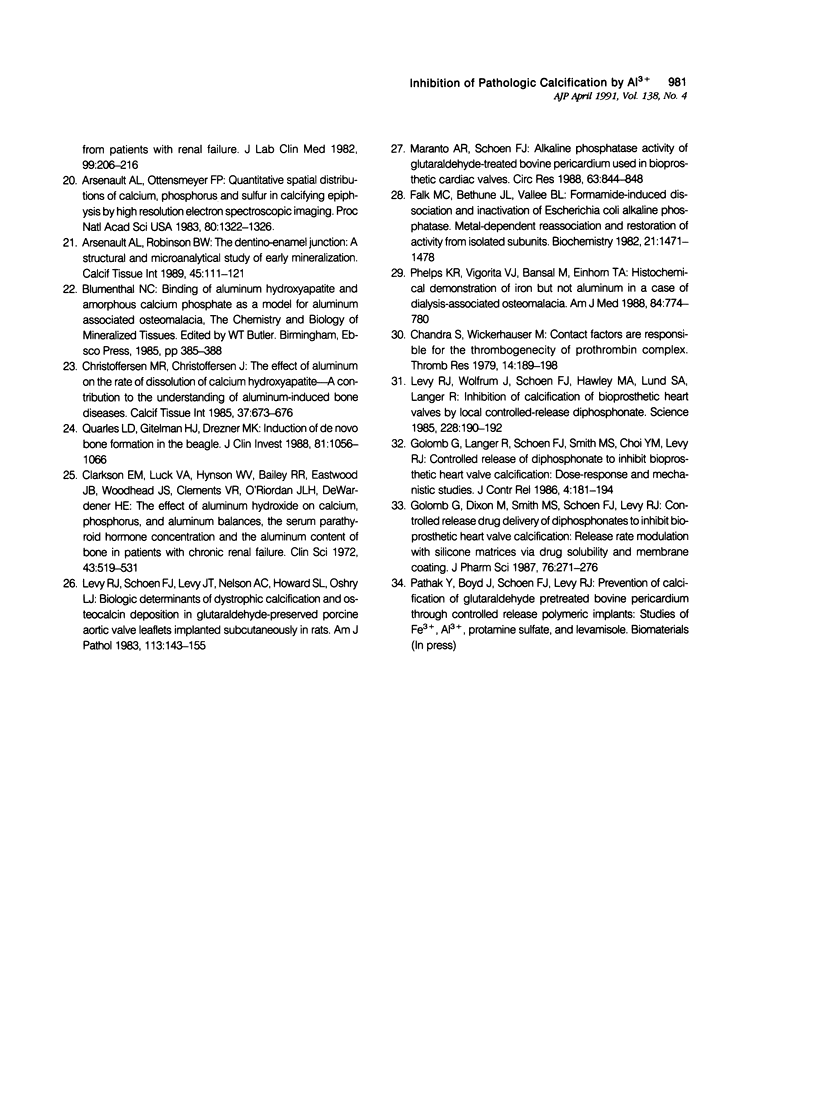
Images in this article
Selected References
These references are in PubMed. This may not be the complete list of references from this article.
- Arsenault A. L., Ottensmeyer F. P. Quantitative spatial distributions of calcium, phosphorus, and sulfur in calcifying epiphysis by high resolution electron spectroscopic imaging. Proc Natl Acad Sci U S A. 1983 Mar;80(5):1322–1326. doi: 10.1073/pnas.80.5.1322. [DOI] [PMC free article] [PubMed] [Google Scholar]
- Arsenault A. L., Robinson B. W. The dentino-enamel junction: a structural and microanalytical study of early mineralization. Calcif Tissue Int. 1989 Aug;45(2):111–121. doi: 10.1007/BF02561410. [DOI] [PubMed] [Google Scholar]
- Chandra S., Wickerhauser M. Contact factors are responsible for the thrombogenicity of prothrombin complex. Thromb Res. 1979 Jan;14(1):189–198. doi: 10.1016/0049-3848(79)90037-9. [DOI] [PubMed] [Google Scholar]
- Christoffersen M. R., Christoffersen J. The effect of aluminum on the rate of dissolution of calcium hydroxyapatite--a contribution to the understanding of aluminum-induced bone diseases. Calcif Tissue Int. 1985 Dec;37(6):673–676. doi: 10.1007/BF02554929. [DOI] [PubMed] [Google Scholar]
- Clark R. A., Krueger G. L. Aluminon: its limited application as a reagent for the detection of aluminum species. J Histochem Cytochem. 1985 Jul;33(7):729–732. doi: 10.1177/33.7.3891845. [DOI] [PubMed] [Google Scholar]
- Clarkson E. M., Luck V. A., Hynson W. V., Bailey R. R., Eastwood J. B., Woodhead J. S., Clements V. R., O'Riordan J. L., De Wardener H. E. The effect of aluminium hydroxide on calcium, phosphorus and aluminium balances, the serum parathyroid hormone concentration and the aluminium content of bone in patients with chronic renal failure. Clin Sci. 1972 Oct;43(4):519–531. doi: 10.1042/cs0430519. [DOI] [PubMed] [Google Scholar]
- Falk M. C., Bethune J. L., Vallee B. L. Formamide-induced dissociation and inactivation of Escherichia coli alkaline phosphatase. Metal-dependent reassociation and restoration of activity from isolated subunits. Biochemistry. 1982 Mar 30;21(7):1471–1478. doi: 10.1021/bi00536a001. [DOI] [PubMed] [Google Scholar]
- Faugere M. C., Arnala I. O., Ritz E., Malluche H. H. Loss of bone resulting from accumulation of aluminum in bone of patients undergoing dialysis. J Lab Clin Med. 1986 Jun;107(6):481–487. [PubMed] [Google Scholar]
- Golomb G., Dixon M., Smith M. S., Schoen F. J., Levy R. J. Controlled-release drug delivery of diphosphonates to inhibit bioprosthetic heart valve calcification: release rate modulation with silicone matrices via drug solubility and membrane coating. J Pharm Sci. 1987 Apr;76(4):271–276. doi: 10.1002/jps.2600760402. [DOI] [PubMed] [Google Scholar]
- Hoekstra D., Wilschut J., Scherphof G. Fusion of erythrocyte ghosts induced by calcium phosphate. Kinetic characteristics and the role of Ca2+, phosphate and calcium-phosphate complexes. Eur J Biochem. 1985 Jan 2;146(1):131–140. doi: 10.1111/j.1432-1033.1985.tb08629.x. [DOI] [PubMed] [Google Scholar]
- LeGendre G. R., Alfrey A. C. Measuring picogram amounts of aluminum in biological tissue by flameless atomic absorption analysis of a chelate. Clin Chem. 1976 Jan;22(1):53–56. [PubMed] [Google Scholar]
- Levy R. J., Hawley M. A., Schoen F. J., Lund S. A., Liu P. Y. Inhibition by diphosphonate compounds of calcification of porcine bioprosthetic heart valve cusps implanted subcutaneously in rats. Circulation. 1985 Feb;71(2):349–356. doi: 10.1161/01.cir.71.2.349. [DOI] [PubMed] [Google Scholar]
- Levy R. J., Schoen F. J., Levy J. T., Nelson A. C., Howard S. L., Oshry L. J. Biologic determinants of dystrophic calcification and osteocalcin deposition in glutaraldehyde-preserved porcine aortic valve leaflets implanted subcutaneously in rats. Am J Pathol. 1983 Nov;113(2):143–155. [PMC free article] [PubMed] [Google Scholar]
- Levy R. J., Wolfrum J., Schoen F. J., Hawley M. A., Lund S. A., Langer R. Inhibition of calcification of bioprosthetic heart valves by local controlled-release diphosphonate. Science. 1985 Apr 12;228(4696):190–192. doi: 10.1126/science.3919445. [DOI] [PubMed] [Google Scholar]
- Marumo F., Nakamura M., Sato N., Shimada H., Tsukamoto S., Iwanami S. Deranged Ca, Al and Mg content in the tissues of patients with chronic renal failure, as measured by non-destructive neutron activation analysis. Int J Artif Organs. 1985 Nov;8(6):319–324. [PubMed] [Google Scholar]
- Meyer J. L., Thomas W. C., Jr Trace metal-citric acid complexes as inhibitors of calcification and crystal growth. I. Effects of Fe(III), Cr(III) and Al(III) complexes on calcium phosphate crystal growth. J Urol. 1982 Dec;128(6):1372–1375. doi: 10.1016/s0022-5347(17)53510-7. [DOI] [PubMed] [Google Scholar]
- Parsons V., Davies C., Goode C., Ogg C., Siddiqui J. Aluminium in bone from patients with renal failure. Br Med J. 1971 Oct 30;4(5782):273–275. doi: 10.1136/bmj.4.5782.273. [DOI] [PMC free article] [PubMed] [Google Scholar]
- Phelps K. R., Vigorita V. J., Bansal M., Einhorn T. A. Histochemical demonstration of iron but not aluminum in a case of dialysis-associated osteomalacia. Am J Med. 1988 Apr;84(4):775–780. doi: 10.1016/0002-9343(88)90119-2. [DOI] [PubMed] [Google Scholar]
- Quarles L. D., Gitelman H. J., Drezner M. K. Induction of de novo bone formation in the beagle. A novel effect of aluminum. J Clin Invest. 1988 Apr;81(4):1056–1066. doi: 10.1172/JCI113417. [DOI] [PMC free article] [PubMed] [Google Scholar]
- Repo M. A., Bockman R. S., Betts F., Boskey A. L., Alcock N. W., Warrell R. P., Jr Effect of gallium on bone mineral properties. Calcif Tissue Int. 1988 Nov;43(5):300–306. doi: 10.1007/BF02556640. [DOI] [PubMed] [Google Scholar]
- Schoen F. J., Fernandez J., Gonzalez-Lavin L., Cernaianu A. Causes of failure and pathologic findings in surgically removed Ionescu-Shiley standard bovine pericardial heart valve bioprostheses: emphasis on progressive structural deterioration. Circulation. 1987 Sep;76(3):618–627. doi: 10.1161/01.cir.76.3.618. [DOI] [PubMed] [Google Scholar]
- Schoen F. J., Hobson C. E. Anatomic analysis of removed prosthetic heart valves: causes of failure of 33 mechanical valves and 58 bioprostheses, 1980 to 1983. Hum Pathol. 1985 Jun;16(6):549–559. doi: 10.1016/s0046-8177(85)80103-9. [DOI] [PubMed] [Google Scholar]
- Schoen F. J., Levy R. J., Nelson A. C., Bernhard W. F., Nashef A., Hawley M. Onset and progression of experimental bioprosthetic heart valve calcification. Lab Invest. 1985 May;52(5):523–532. [PubMed] [Google Scholar]
- Schoen F. J., Tsao J. W., Levy R. J. Calcification of bovine pericardium used in cardiac valve bioprostheses. Implications for the mechanisms of bioprosthetic tissue mineralization. Am J Pathol. 1986 Apr;123(1):134–145. [PMC free article] [PubMed] [Google Scholar]
- Sedman A. B., Klein G. L., Merritt R. J., Miller N. L., Weber K. O., Gill W. L., Anand H., Alfrey A. C. Evidence of aluminum loading in infants receiving intravenous therapy. N Engl J Med. 1985 May 23;312(21):1337–1343. doi: 10.1056/NEJM198505233122101. [DOI] [PubMed] [Google Scholar]
- Webb C. L., Flowers W. E., Boyd J., Rosenthal E. L., Schoen F. J., Levy R. J. Al+++ binding studies and metallic cation effects on bioprosthetic heart valve calcification in the rat subdermal model. ASAIO Trans. 1990 Apr-Jun;36(2):56–59. doi: 10.1097/00002480-199004000-00003. [DOI] [PubMed] [Google Scholar]








